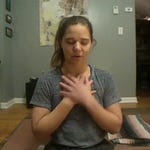Hi!
Here’s a 75 min intermediate(ish) class for you, in which we explore Natarajasana, or Dancer pose, by introducing mild backbends, bringing awareness to the spine, opening up through the chest & shoulders and warming the hip flexors. It’s fun, with lots of opportunities to backbend. Read on for a little philosophical and anatomical background on the pose itself!
The symbolism:
Like many of the asanas we practice, Natarajasana has a story behind it. This backbending-while-balancing shape comes from a myth in which Lord Shiva, god of creation, destruction and transformation, discovers that his wife, Sati, has been killed. His grief spurs him into a passionate dance of destruction, a dance that “lays the foundation for the creation and sustenance of the universe.1”
We often see depictions of Shiva dancing upon a demon (representing avidya, or ignorance) in a ring of fire (symbolizing the cycle of samsara: birth, death and rebirth). Natarajasana, then, is a symbol of constant change, and of wise action. Shiva energy asks us to maintain balance in the midst of intensity, to dance in the face of chaos, to feel into the ever-changing nature of all things, and to be honest about our limitations.

“Look at an apple or a rock. Not much change will take place in the next hour, or even the next day, unless you intervene— drop it, break it, or put it in water or fire. But the molecules are changing, some things are breaking down and others are forming. In the case of the apple, within a week, you will see it begin to rot, which is a way of changing form so that new apples can be born from the seeds of this one. In the case of the rock, change might not be visible in your lifetime. That principle that causes change— encompassing both the death and decay of the old apple and the sprouting seeds that will someday produce new apples— that principle is Shiva, Lord of the Dance.”
—Downward Dogs & Warriors: Wisdom Tales for Modern Yogis, by Zo Newell
The anatomy:
We don’t go for the grabbing-the-foot-overhead expression in this class, because I want you to see what it feels like to initiate your backbend from the thoracic segment of the spine (at chest level), versus from the lumbar (lowermost) segment. That being said, go for it, if you want to. Just keep in mind that the low back tends to want to “do the work” in deeper backbends, because it is usually more naturally mobile than the rest of the spine. The wonderful Jenni Rawlings writes: “On an anatomical level, the main reason to practice backbends is to mobilize the spine in the direction of extension,” so it makes sense to focus on areas of our spine that tend to feel a bit stuck or “glommed up,” rather ones that are already very mobile, and possibly hypermobile.
Think about paying close attention to the movement of the thoracic spine in your warm up. See if you can picture the vertebrae moving individually, like beads on a necklace2— even if you can’t quite feel that, can you visualize it in your mind’s eye? When it comes time to backbend more deeply, this awareness can aid in your ability to distribute your backbend more evenly rather than dump into the low back, which can bring in too much compressive force to the lumbar area.

The why behind your backbending practice:
Do you backbend because it makes you feel joyful and free? Do you like how it looks? Are you looking to bring more mobility and flexibility into the spine? Investigating your “why” can influence your “how”.
More considerations for Dancer pose:
How far are you willing to go to challenge yourself? Where do you notice the breath in this pose? Is it still fun? Does it feel like an expression of anger, grief or grasping, or a playful exploration of limits? What is ignorant action here? Wise action?
Personally, Natarajasana reminds me of this: that unless I surrender to the universal truth that EVERYTHING IS CHANGING ALL THE TIME, I will always, always create more suffering for myself. The wobbliness of balancing while backbending challenges me to stay present, be honest about my physical capabilities, to not to take things too seriously and enjoy the ride. Can’t stop the waves, but you can learn how to surf, ya know?!
Love to hear your thoughts!
Take good care,
Berlin
https://www.yogajournal.com/practice/yoga-sequences/joy-to-the-world/
A lovely cue borrowed from Mary Bond









